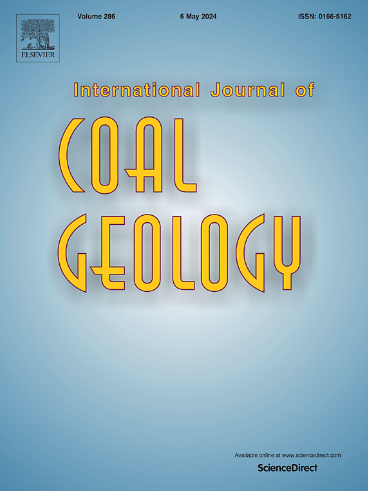丹麦北海枯竭马斯特里赫特白垩储层中剩余可移动和不可移动石油馏分的空间分布:对二氧化碳封存的影响
IF 5.6
2区 工程技术
Q2 ENERGY & FUELS
引用次数: 0
摘要
枯竭油气田是地下二氧化碳的潜在重要封存地点,但在白垩中大规模注入超临界(sc)二氧化碳尚未尝试过。风险之一是白垩储层中大量剩余石油对 scCO2 注入的不利影响。为了消除对注入率的不利影响,必须从根本上了解剩余石油中可移动、半可移动和不可移动石油以及固体沥青/沥青质馏分的空间分布和数量。本研究将有机地球化学(饱和馏分的气相色谱法和程序热解)和反射光显微镜相结合,对北海丹麦中央海湾水淹马斯特里赫特白垩系储层中一个明确储层区间内不同油馏分的空间分布、体积和饱和度进行了评估和测量。共分析了来自哈夫丹和丹油田的一口略微偏离的垂直井和两口长达 5 千米的水平井的 127 个样本。油藏中原有的石油饱和度和成分分布不均或不同层位的生产效率不同,可能是总石油和石油馏分饱和度变化的原因。气相色谱法显示,溶剂萃取油的成分非常相似,以极性化合物为主,沥青质含量较高。延长缓慢加热(ESH)热解显示,剩余油饱和度大部分由半可移动油和总不可移动油(不可移动油加上固体沥青/沥青质)组成。石油重力值(API)的降低与岩心储存期间最轻碳氢化合物馏分的蒸发损失以及生产期间注水导致较重石油馏分相对比例的增加有关。显微镜检查发现了三种形式的石油:i) 斑状分布的较轻的可移动石油,呈现蓝色荧光;ii) 带有深橙色至褐色荧光的褐色染色;iii) 暗褐色无荧光石油和黑色固体沥青/沥青质,出现在微化石中,沿着变形带和花柱岩,构成了重的不可移动石油馏分。岩体孔隙度与不可移动石油总饱和度之间存在普遍的相关性。由此看来,重质不可移动石油馏分优先出现在高渗透性地层区间内的低渗透性异质中。这些区段似乎有利于不可移动石油和固体沥青/沥青质的积累,并可能具有较高的阻碍 scCO2 流动的风险。本文章由计算机程序翻译,如有差异,请以英文原文为准。
Spatial distribution of remaining movable and non-movable oil fractions in a depleted Maastrichtian chalk reservoir, Danish North Sea: Implications for CO2 storage
Depleted oil and gas fields constitute potentially important storage sites for CO2 in the subsurface, but large-scale injection of supercritical (sc) CO2 in chalk has not yet been attempted. One of the risks is the adverse effect of the substantial amount of remaining oil in the chalk reservoirs on scCO2 injection. In order to counter an undesired effect on injectivity, a fundamental understanding of the spatial distribution and quantity of the movable, semi-movable, and non-movable oil, and solid bitumen/asphaltenes fractions of the remaining oil is critical. In this study a combination of organic geochemistry (gas chromatography of the saturated fraction and programmed pyrolysis), and reflected light microscopy was applied to evaluate and measure the spatial distribution, volume, and saturation of different oil fractions in a well-defined reservoir interval of a waterflooded Maastrichtian chalk reservoir in the Danish Central Graben, North Sea. A total of 127 samples from a slightly deviated vertical well and two ∼5 km-long horizontal wells from the Halfdan and Dan fields were analyzed. An original uneven distribution of oil saturation and composition or different production efficiency of different levels in the reservoir may account for variations in the total oil and oil fraction saturations. Gas chromatography shows that the solvent extractable oil is quite similar in composition, characterized by a dominance of polar compounds and a high content of asphaltenes. Extended slow heating (ESH) pyrolysis reveals that most of the remaining oil saturation consists of semi-movable oil and total non-movable oil (non-movable oil plus solid bitumen/asphaltenes). Reduced oil gravity values (API) are related to evaporation loss of the lightest hydrocarbon fraction during core storage and increase of the relative proportion of the heavier oil fractions by waterflooding during production. Microscopy disclosed three forms of oil: i) Patchy distributed lighter, movable oil showing a bluish fluorescence, ii) Brownish staining with a dark orange to brownish fluorescence, and iii) Dark brown non-fluorescing oil and black solid bitumen/asphaltenes occurring in microfossils and along deformation bands and stylolites, constituting the heavy non-movable oil fractions. There is a general correlation between bulk rock porosity and the total non-movable oil saturation. It thus appears that the heavy non-movable oil fractions preferentially occur in association with low-permeability heterogeneities within high-permeability stratigraphic intervals. These intervals appear to favor accumulation of non-movable oil and solid bitumen/asphaltenes and may carry a higher risk for impeding scCO2 flow.
求助全文
通过发布文献求助,成功后即可免费获取论文全文。
去求助
来源期刊

International Journal of Coal Geology
工程技术-地球科学综合
CiteScore
11.00
自引率
14.30%
发文量
145
审稿时长
38 days
期刊介绍:
The International Journal of Coal Geology deals with fundamental and applied aspects of the geology and petrology of coal, oil/gas source rocks and shale gas resources. The journal aims to advance the exploration, exploitation and utilization of these resources, and to stimulate environmental awareness as well as advancement of engineering for effective resource management.
 求助内容:
求助内容: 应助结果提醒方式:
应助结果提醒方式:


